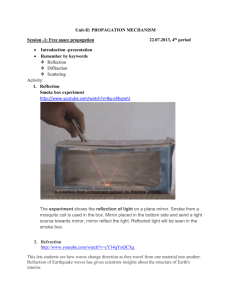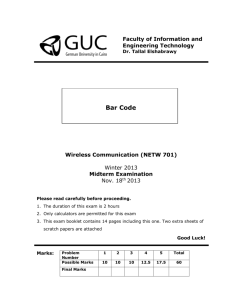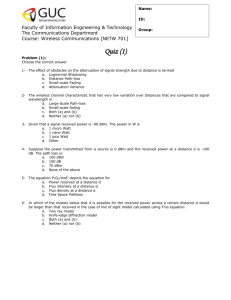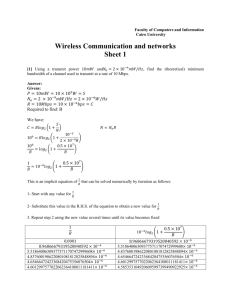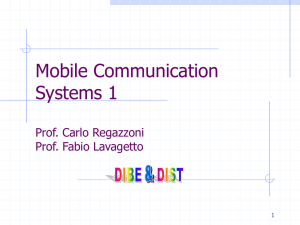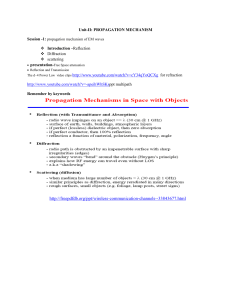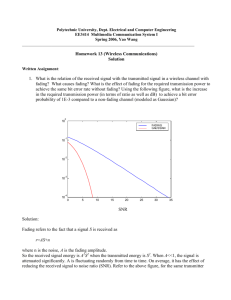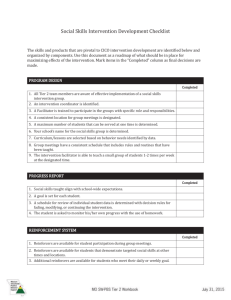View File - University of Engineering and Technology, Taxila
advertisement
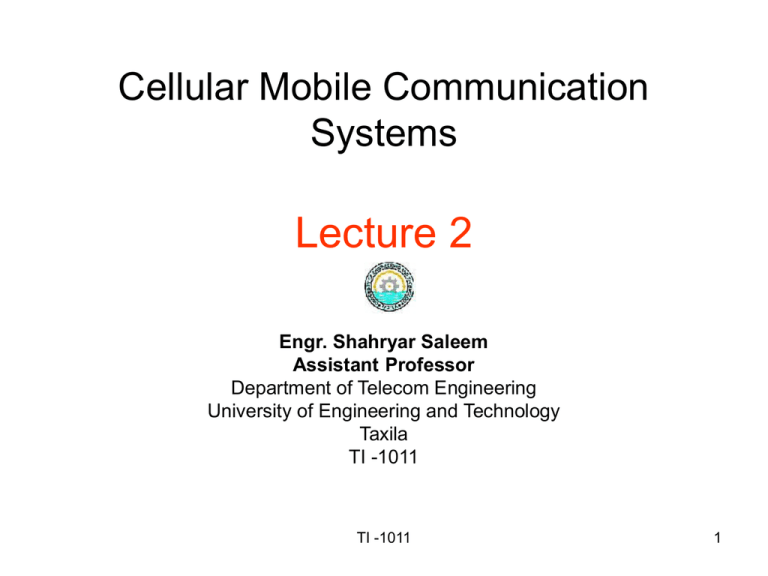
Cellular Mobile Communication Systems Lecture 2 Engr. Shahryar Saleem Assistant Professor Department of Telecom Engineering University of Engineering and Technology Taxila TI -1011 TI -1011 1 Wireless Issues • Wireless link implications – communications channel is the air • poor quality: fading, shadowing, weather, etc. – regulated by governments • frequency allocated, licensing, etc. – limited bandwidth • Low bit rate, frequency planning and reuse, interference – power limitations • Power levels regulated, must conserve mobile terminal battery life – security issues • wireless channel is a broadcast medium! • Wireless link implications for communications – How to send signal? – How to clean up the signal in order to have good quality – How to deal with limited bandwidth? • Design network and increase capacity/share bandwidth in a cell TI -1011 2 Typical Wireless Communication System TI -1011 3 Components of Communication System • Source – Produces information for transmission (e.g., voice, keypad entry, etc.) • Source encoder – Removes the redundancies and efficiently encodes the information • Channel encoder – Adds redundant bits to the source bits to recover from any error that the channel may introduce • Modulator – Converts the encoded bits into a signal suitable for transmission over the channel • Antenna – A transducer for converting guided signals in a transmission line into electromagnetic radiation in an unbounded medium or vice versa • Channel – Carries the signal, but will usually distort it • Receiver – reverses the operations TI -1011 4 What is Signal Propagation • How is a radio signal transformed from the time it leaves a transmitter to the time it reaches the receiver • Important for the design, operation and analysis of wireless networks – Where should base stations/access points be placed – What transmit powers should be used – What radio frequencies need be assigned to a base station – How are handoff decision algorithms affected… • Propagation in free open space like light rays • In general make analogy to light and sound waves TI -1011 5 Signal Propagation • Received signal strength (RSS) influenced by – Fading – signal weakens with distance - proportional to1/d² (d = distance between sender and receiver) – Frequency dependent fading – signal weakens with increase in f – Shadowing (no line of sight path) – Reflection off of large obstacles – Scattering at small obstacles – Diffraction at edges TI -1011 6 Signal Propagation • Effects are similar indoors and outdoors • Several paths from Tx to Rx – Different delays, phases and amplitudes – Add motion – makes it very complicated TI -1011 7 Multipath Propagation • Signal can take many different paths between sender and receiver due to reflection, scattering, diffraction • Time dispersion: signal is dispersed over time interference with “neighbor” symbols, Inter Symbol Interference (ISI) • The signal reaches a receiver directly and phase shifted distorted signal depending on the phases of the different parts TI -1011 8 Effects of Mobility • Time Variations in Signal Strength • Channel characteristics change over time and location – signal paths change – different delay variations of different signal parts – different phases of signal parts • Quick changes in the power received (short term or fast fading) • Slow changes in the average power received (long term fading) • Additional changes in; – distance to sender – obstacles further away TI -1011 9 Fading • Fading refers to the Time variation of the received signal power caused by the changes in the telecommunication medium or path. • When a signal is transmitted from a sender to the receiver multiple copies of the signal are formed due to the obstructions in the path between sender and receiver. Each signal copy will experience different; – Attenuation – Delay – Phase shift • This can result in either constructive or destructive interference, amplifying or attenuating the signal power as seen at the receiver. TI -1011 10 Types of Fading • Slow fading/ Shadowing/ Long Term Fading/ Large Scale Fading: Caused by larger movements of the mobile or obstructions within the propagation environment. • Fast Fading/ Multipath Fading/ Short Term Fading/ Small Scale Fading: Caused by the small movements of the mobile or obstruction. TI -1011 11 Communication Issues and Radio Propagation • Three main issues in radio channel – Achievable signal coverage • What is geographic area covered by the signal • Governed by path loss – Achievable channel rates (bps) • Governed by multipath delay spread – Channel fluctuations – effect data rate • Governed by Doppler spread and multipath TI -1011 12 Communication Issues and Radio Propagation TI -1011 13 Coverage • Determines – Transmit power required to provide service in a given area (link budget) – Interference from other transmitters – Number of base stations or access points that are required • Parameters of importance (Large Scale/ long Term Fading effects) – Path loss (long term fading) – Shadow fading (No LOS) TI -1011 14 Signal Coverage Range • Transmission range – communication possible – low error rate • Detection range – detection of the signal possible – no communication possible • Interference range – signal may not be detected – signal adds to the background noise TI -1011 15 Decibels • Power (signal strength) is expressed in decibels (dB) for ease of calculation – Values relative to 1 mW are expressed in dBm – Values relative to 1 W are expressed in dBW – Other values are simply expressed in dB • Example 1: Express 2 W in dBm and dBW – dBm: 10 log10 (2 W / 1 mW) = 10 log10(2000) = 33 – dBW: 10 log10 (2 W / 1 W) = 10 log10(2) = 3 dBW dBm • In general dBm value = 30 + dBW value TI -1011 16 Free Space Loss Model • Assumptions – Transmitter and receiver are in free space – No obstructing objects in between – The earth is at an infinite distance! – The transmitted power is Pt – The received power is Pr – Isotropic antennas • Antennas radiate and receive equally in all directions with unit gain • The path loss is the difference between the received signal strength and the transmitted signal strength PL = Pt (dB) – Pr (dB) TI -1011 17 Free Space Loss • Transmit power Pt • Received power Pr • Wavelength of the RF carrier λ = c/f • Over a distance d the relationship between Pt and Pr is given by: • In dB, we have: • Pr (dBm)= Pt (dBm) - 21.98 + 20 log10 (λ) – 20 log10 (d) • Path Loss = PL = Pt – Pr = 21.98 - 20log10(λ) + 20log10 (d) TI -1011 18 Free Space Propagation • Notice that factor of 10 increase in distance => 20 dB increase in path loss (20 dB/decade) Distance d= 1km d= 10Km Path Loss @ 880 MHz PL= 91.29 dB PL= 111.29 dB • Note that higher the frequency the greater the path loss for a fixed distance Distance 1km PL @ 880 MHz PL @ 1960MHz 91.29 dB 98.25 dB • Thus 7 dB greater path loss for PCS band compared to cellular band TI -1011 19 Example Can use model to predict coverage area of a base station TI -1011 20 A Simple Explanation of Free Space Propagation • • • • Isotropic transmit antenna – Radiates signal equally in all directions Assume a point source – At a distance d from the transmitter, the area of the sphere enclosing the Tx is A = 4πd2 – The “power density” on this sphere is Pt / 4πd2 Isotropic receive antenna – Captures power equal to the density times the area of the antenna – Ideal area of antenna is Aant = λ2/4π The received power is: Pr = Pt / 4πd2 × λ2/4π = Pt λ2/(4πd)2 TI -1011 21 Isotropic and Real Antennas • Isotropic antennas are “ideal” and cannot be achieved in practice – Useful as a theoretical benchmark • Real antennas have gains in different directions – Suppose the gain of the transmit antenna in the direction of interest is Gt and that of the receive antenna is Gr – The free space relation is: Pr = Pt Gt Gr λ2/(4πd)2 • The quantity Pt Gt is called the effective isotropic radiated power (EIRP) – This is the transmit power that a transmitter should use were it having an isotropic antenna TI -1011 22 Two-Ray Model for Mobile Radio Environment Where; d1= line of sight path d2= ground reflected paths ht= Height of the transmitter hr= Height of the receiver TI -1011 23 Two-Ray Model for Mobile Radio Environment • Using the method of images the line-of-sight path and the ground reflected path can be calculated TI -1011 24 Received Power for Two-Ray Model • From the image diagram we have; • The relationship between the transmit power and the received power is; • Notice that factor of 10 increase in distance => 40 dB increase in path loss (40 dB/decade) • The Received Power can be increased by raising the heights of the transmit and receive antenna TI -1011 25 Diffraction Loss • Diffraction occurs when the radio path between the Tx and Rx is obstructed by surfaces that have sharp edges • Edges act as a secondary line source • The diffraction parameter ν is defined as • hm is the height of the obstacle • dt is distance transmitter-obstacle • dr is distance receiver-obstacle TI -1011 The diffraction loss Ld (dB) is approximated by 26 Diffraction Example TI -1011 27 Path Loss Models • Commonly used to estimate link budgets, cell sizes and shapes, capacity, handoff criteria etc. • “Macroscopic” or “large scale” variation of RSS • Path loss = loss in signal strength as a function of distance – Terrain dependent (urban, rural, mountainous), ground reflection, diffraction, etc. – Site dependent (antenna heights for example) – Frequency dependent – Line of site or not TI -1011 28 Environment Based Path Loss Model • Basic characterization: LP = L0 + 10α log10(d) – L0 is termed the frequency dependent component – The parameter α is called the “path loss gradient” or exponent – The value of α determines how quickly the RSS falls • α determined by measurements in typical environment – For example • α = 2.5 might be used for rural area • α = 4.8 might be used for dense urban area • Variations on this approach – Try and add more terms to the model – Directly curve fit data • Indoor and Outdoor Models – Okumura-Hata, COST 231, JTC TI -1011 29 Shadow Fading • The signal strength for the same distance from the TX and RX is different for different locations depending upon the environment • LP= L0 + 10α log (d) provides the mean value of the received signal strength at distance ‘d’ • The variation of the signal strength around this value is known as Shadow fading or Slow fading • The path loss equation becomes; LP= L0 + 10α log (d) + X • Where X is the random variable whose distribution depends on the fading component • Measurement studies show that X can be modeled with a lognormal distribution with mean = zero and standard deviation σ db TI -1011 30 Fade Margin • In order to provide adequate signal strengths to locations where transmitted signal may no reach • Add a Fade Margin to the path loss or the received signal strength LP= L0 + 10α log (d) + F • Where F is the Fade Margin associated with the path loss to overcome the shadow fading effects • Fade Margin can be applied by • – Reducing cell size • – Increasing transmit power • – Making the receiver more sensitive TI -1011 31 Path Loss for Macrocellular Areas Okumura-Hata Model • Okumura collected measurement data ( in Tokyo) and plotted a set of curves for path loss in urban areas – Frequency range 100 MHz to 1,920 MHz – Identified the height of the Tx and Rx as important parameters • Hata came up with an empirical model for Okumura’s curves Lp = 69.55 + 26.16 log fc – 13.82 log hte – a(hre) + (44.9–6.55 log hte)log d • Where fc is in MHz, d is distance in km, and hte is the base station transmitter antenna height in meters and hre is the mobile receiver antenna height in meters • for fc > 400 MHz and large city • a(hre) = 3.2 (log [11.75 hre])2 – 4.97 dB • See Table 2.1 in textbook for other cases TI -1011 32 Example of Hata’s Model • Consider the case where hre = 2 m, receiver antenna’s height hte = 100 m, transmitter antenna’s height fc = 900 MHz, carrier frequency • Lp = 118.14 + 31.8 log d – The path loss exponent for this particular case is α = 3.18 • What is the path loss at d = 5 km? – d = 5 km Lp = 118.14 + 31.8 log 5 = 140.36 dB • If the maximum allowed path loss is 120 dB,what distance can the signal travel? • – Lp = 120 = 118.14 + 31.8 log d => d =10(1.86/31.8) = 1.14 km TI -1011 33 COST Model • Models developed by COST – European Cooperative for Science and Technology – Collected measurement data – Plotted a set of curves for path loss in various areas around the 1900 MHz band – Developed a Hata-like model Lp = 46.3 + 33.9 log fc – 13.82 log hte - a(hre) + (44.9 –6.55 log hte)log d + C • C is a correction factor – C = 0 dB in dense urban; -5 dB in urban; -10 dB in suburban; -17 dB in rural • Note: fc is in MHz (between 1500 and 2000 MHz), d is in km, hte is effective base station antenna height in meters (between 30 and 200m), hre is mobile antenna height (between 1 and 10m) TI -1011 34 Path Loss Models for Microcellular Areas • • • • Area of the microcell spans from 1m to a kilometer Supported by below the roof top antennas mounted on lampposts Streets acts as urban canyons Propagation of the signal is affected by – reflection from buildings and ground – Scattering from vehicles – Diffraction around building and rooftops • Bertoni and others have developed empirical path-loss models similar to Okumura-Hata models • See table 2.2 in the text book for the Path-loss models TI -1011 35 Path Loss Models for Microcellular Areas • d is the distance between the mobile and the transmitter in Kilometers • hb is the height of the base station • hm is the height of the mobile • fc is the centre frequency of the carrier in GHz and ranges between 0.9 - 2 GHz • In addition other parameters are – rh, the distance of the mobile from the last rooftop in meters – Δhm is the height of the nearest building above the height of the receiver – Δh is the relative height of the base station compared to the average height of the buildings TI -1011 36 Path Loss Models for Picocellular Indoor Areas • Picocells correspond to radio cells covering a building or parts of a building • Area of picocells spans from 30m to 100m • Employed for WLANs, Wireless PBX systems and PCS operating in indoor areas • Three models for Indoor Areas – Multifloor Attenuation Model – JTC Model => improvement to the Multifloor Attenuation Model – Partition Dependant Model TI -1011 37 Multifloor Attenuation Model • • • • • • • • Describing path loss in multistory building Signal Attenuation by the floors is a constant independent of distance The path loss is; Lp=L0 + nF+ 10 log (d) F is the signal attenuation provided by each floor L0 is the path loss at first meter, L0 = 10 log (Pt) – 10 log (P0) d is the distance between the Tx and the Rx in meters n is the number of floors through which the signal passes For indoor measurements at 900 MHz and 1.7 GHz, F=10dB and 16 dB TI -1011 38 JTC Model Lp= A + Lf (n) + B log (d) + X • A is an environment dependent fixed loss factor (dB) • B is the distance dependent loss coefficient • d is separation distance between the base station and portable, in meters • Lf is a floor penetration loss factor (dB) • n is the number of floors between the access point and mobile terminal • Xσ is a shadowing term TI -1011 39 JTC Model (cont.) TI -1011 40 Partition Loss Model • Fixing the value of the Path Loss gradient α = 2 for free space • Introducing the losses for each partition • • • • • mtype = the number of partitions of type wtype = the loss in dB associated with that partition d = distance between transmitter and receiver point in meter X = the shadow fading L0 = the path loss at the first meter, computed by • where d0 = 1 m. • f = operating frequency of the transmitter TI -1011 41 Partition Loss Model TI -1011 42 THE END TI -1011 43

